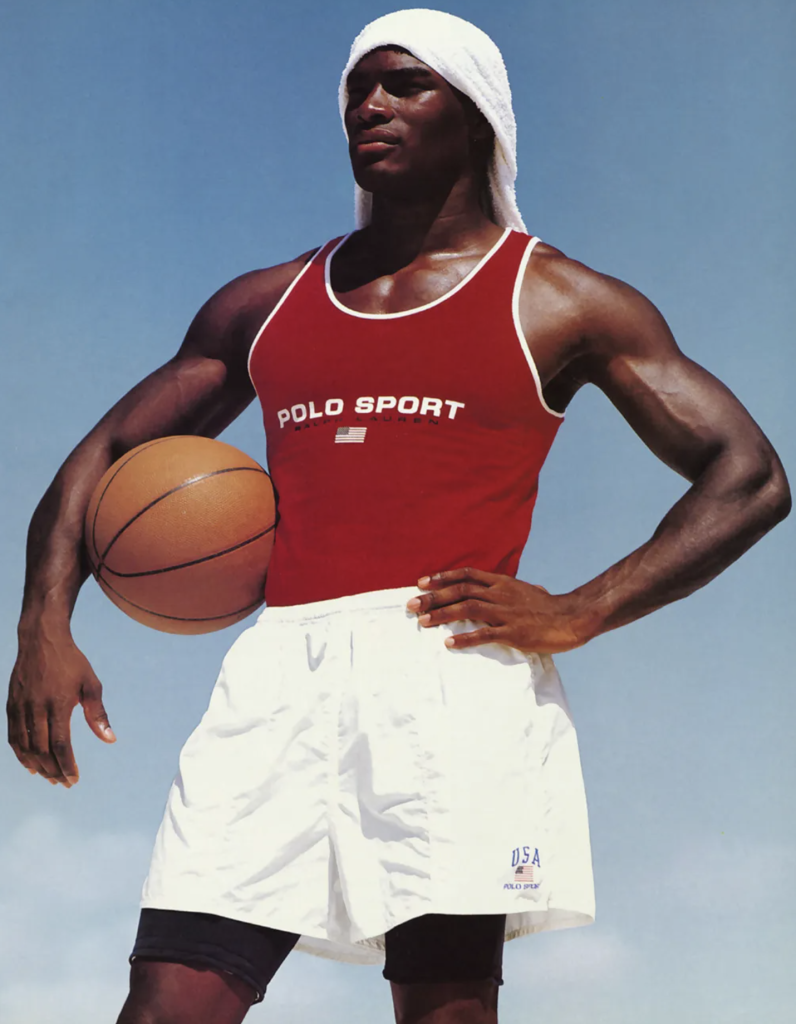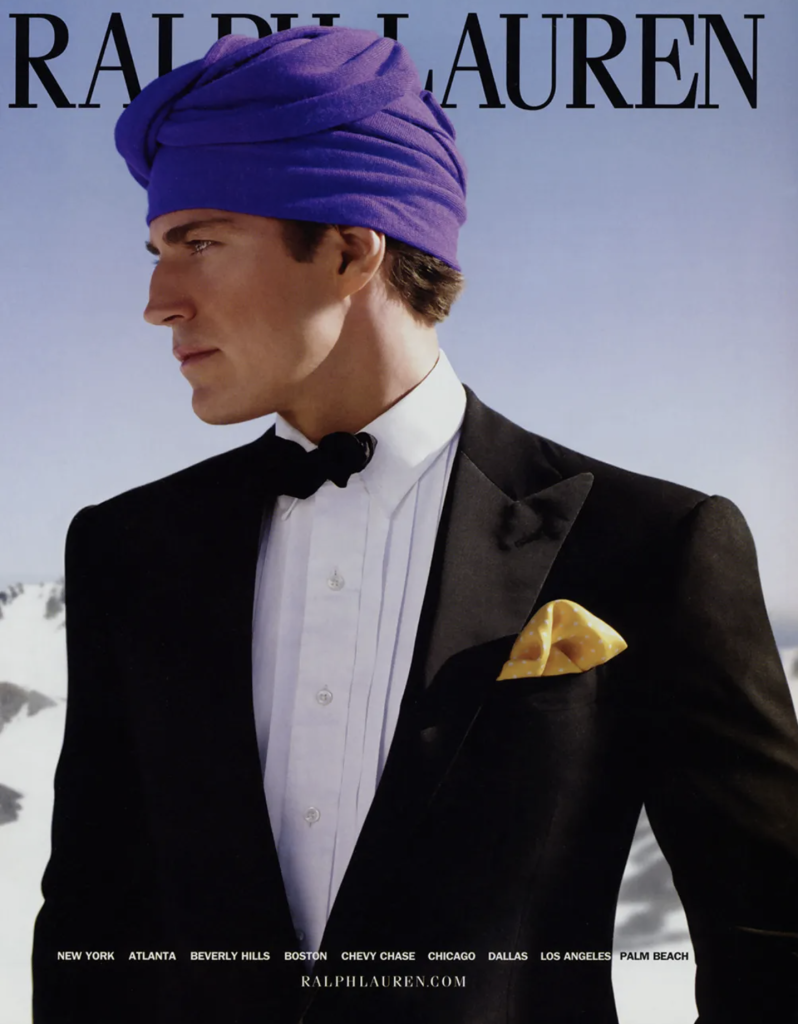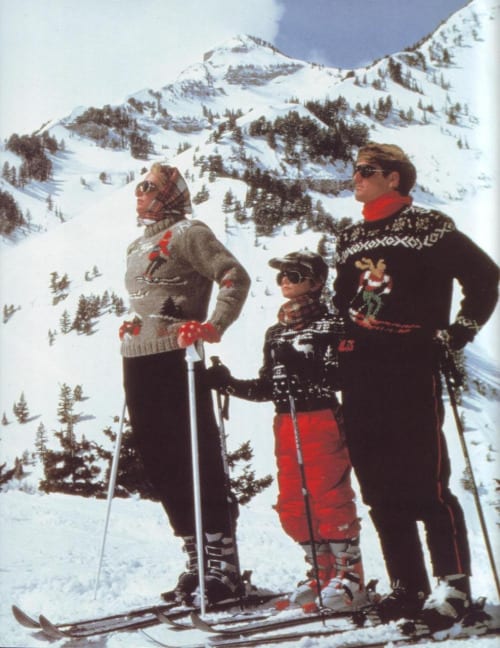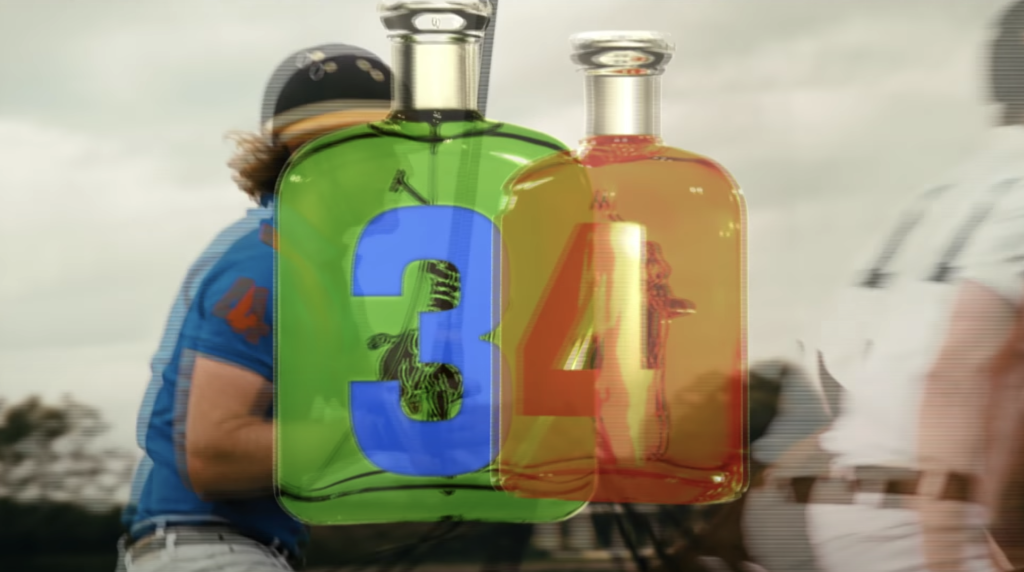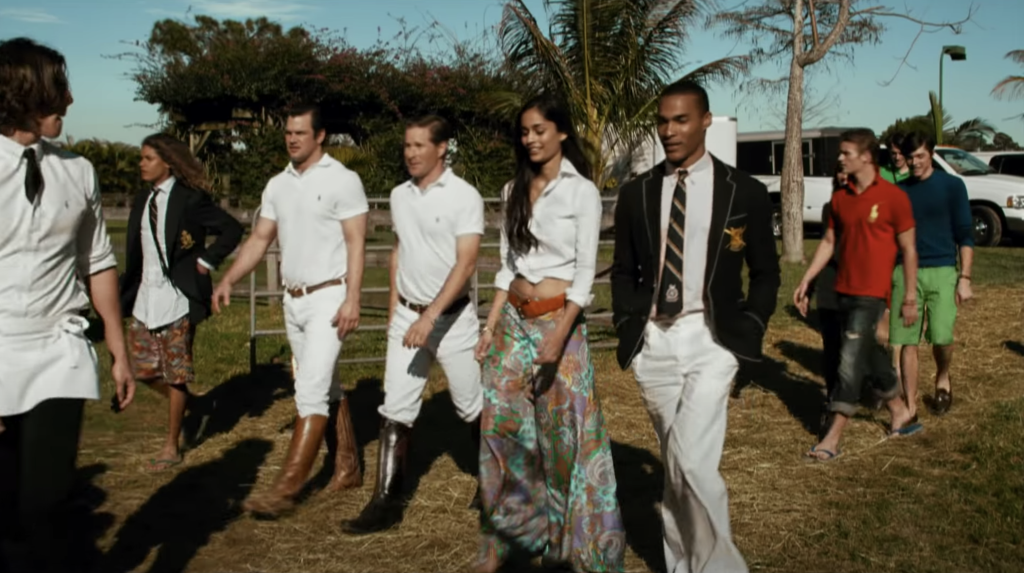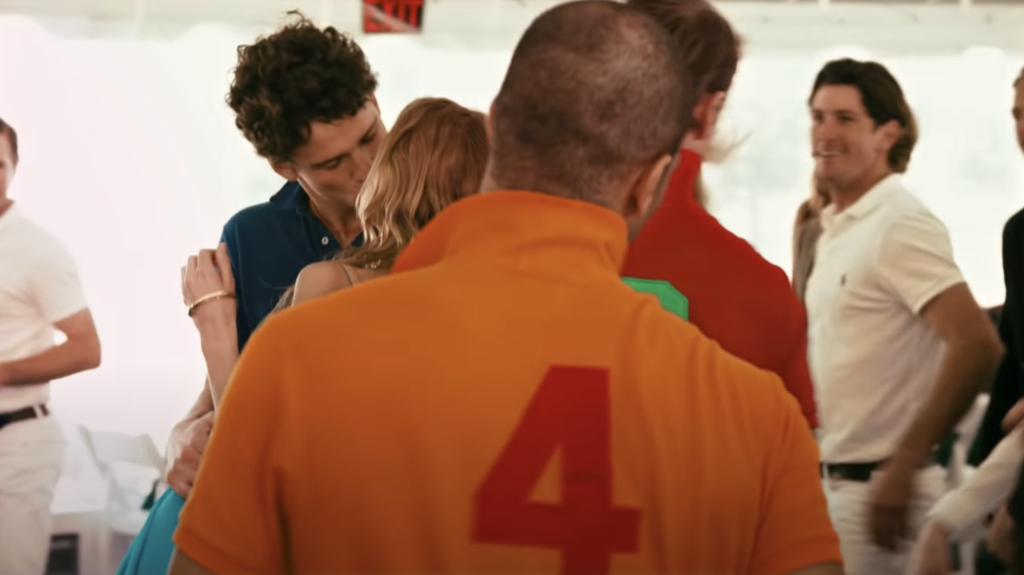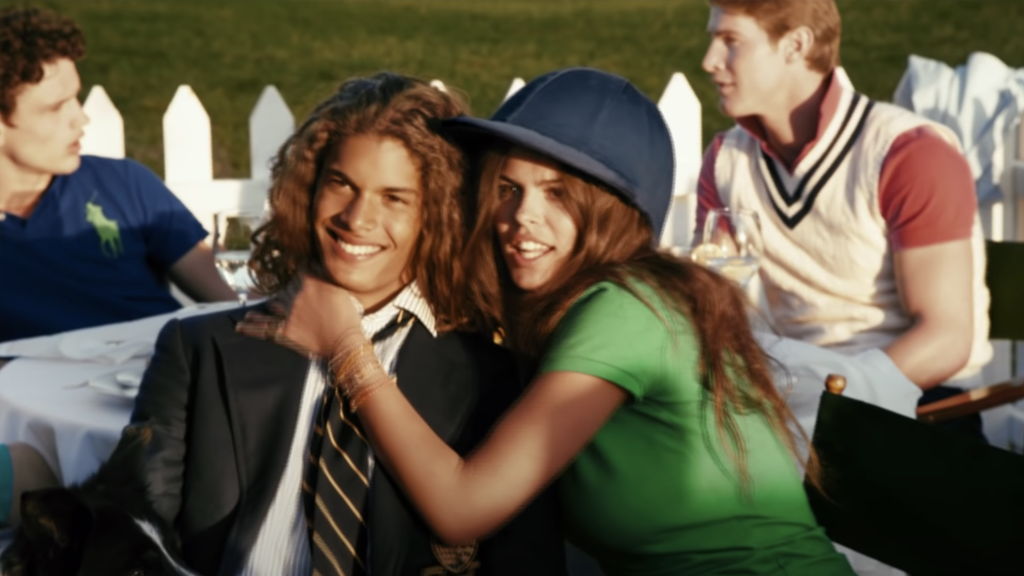- Home
- Academics
- First-Year Writing
- Phoenix Rhetorix
- 2021-2022 Journal
- Ralph Lauren is Reinforcing, not Reimagining, the American Dream by Aniya Arnold
Ralph Lauren is Reinforcing, not Reimagining, the American Dream by Aniya Arnold
Ralph Lauren is Reinforcing, not Reimagining,
the American Dream
An Argumentative Essay by Aniya Arnold
If there’s any concrete definition for the term “American Dream,” Ralph Lauren would be one of the most notable and influential examples from the 20th century. In 1967, Lauren launched “Polo,” which exclusively sold neckwear for men. To get his business up and running, he worked out of a cramped drawer in the Empire State Building while living in a tiny NYC apartment with his wife–such humble beginnings!
But the tides quickly turned for Ralph Lauren when his shop opened in Bloomingdales just two years after the creation of his brand, allowing him to fully actualize his voice as one of the nation’s top designers. In other words, he struck gold. The iconic polo shirt was released in 1972, and when interviewed about the style (Ralphlauren.com), Lauren said, “On one level, there is a certain aspirational quality to having a polo player on it, on another level, it’s just a great shirt with lots of colors.”
But this tiny logo is about more than pretty colors, or even style—Lauren is right, there is an aspirational quality to the clothing and the advertising that his larger-than-life company produces. Advertisements (like the one shown in Figure 1) reinforce the idea that a white nuclear family is the primary representation of luxury and success. When Ralph Lauren consistently reiterates in different ways that his vision for his company consists of “rich American heritage” (Martin Roll)–and the main individuals who model this clothing are white, straight, visibly wealthy, and oftentimes male—whose heritage are we really referring to here?
Don’t worry! You don’t have to answer these intimidating questions, but let’s look at some of the less “aesthetically appealing” advertisements that include some problematic fashion choices that Lauren has greenlighted in the past few decades. We could talk about Ralph Lauren’s use of Black male models only for his early fitness campaigns (Figure 2), or letting a white man wear a turban as a fashion accessory (Tashjian, Figure 3), but those controversies are minuscule compared to Lauren’s true commercial messaging: that whiteness is the standard for luxury.
Now I know what you’re probably thinking: “Whoa there, chill out Aniya! These are gorgeously produced fashion commercials with gorgeous people, not The Birth of a Nation!” And you would have a point. But the decisions that Lauren and a lot of other fashion moguls make are often deeply rooted in what they believe an American does and should look like (cis, white, and male-identifying). So these messages are also deeply embedded in the content that they release. And oftentimes, whether they like it or not, these biases weigh heavily on who they let wear the clothes they make.
As Ralph Lauren’s empire continues to prove itself to be a relevant force in the 21st century (specifically in the mid 2000s), the “American Dream” still rests comfortably upon the pleasures and aspirations of white men. Those who aren’t a part of that identity group are supposed to help them achieve and maintain these goals and the institutions that cultivate them.
Ralph Lauren’s Secrets (Extended) commercial (2010) in particular is wildly entertaining because there are just so many beautiful people. It’s almost sickening. But the many beautiful people also distract from the real message of this commercial: that the pleasure of white men will always be prioritized (Youtube.com). Have you ever played polo before? Like actual horse-and-stick polo? Nope, me neither! But this advertisement is rooted in tradition and what the “true American experience” should look like, traditions that state that women and minorities should take the backseat and act as side characters to the wild and wonderful plot of the white man’s life.
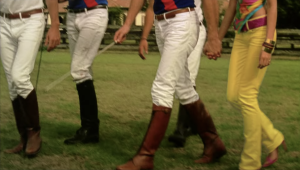
Figure 4
Secrets (Extended) begins with a tight shot of hooves galloping in slow motion, effectively setting the scene for what will take place during the day in this utopia. Then there is a quick, almost one second shot of a group of models, walking through a field; they are mostly white and male, except for the one woman holding hands with one of the models (Figure 4). She is attached while her male counterparts get to walk freely. Already the power structure for this commercial is established: Lauren and his creative team are hinting at who deserves to be the primary representatives of his clothes line.
Then, pictures of the fragrance (from the company’s Big Pony Collection) that is being advertised float over a video of two white men gleefully playing polo (Figure 5), making the statement that this fragrance is for them. Not you. These are the only two people that the fragrance is actually shown with, and that’s important because it sells the idea that their target demographic is not inclusive: it’s for one type of man who lives (or yearns to live) one kind of life.
Then we have a formal establishing shot with –– wait, are those minorities in Figure 6?! Wow! Guys we did it–two out of the 10 models in this shot are people of color. Thanks, Ralph Lauren :). As we go further into the ad, there’s an important pattern to recognize. The shots that are roughly two seconds long and occur sporadically throughout the commercial consist of women and minority models, while the scenes that last roughly 10 seconds consist of white men. This time difference showcases a reluctance to make people associate this fragrance with femininity (God forbid!) or with a Black or Brown face.
Fragrance commercials infamously represent extreme femininity or masculinity, and Lauren’s ad is no different. Companies like Tom Ford and Burberry capitalize on outdated ideas of the essence of what a man should be and we eat it up because it appeals to our traditional perceptions of masculinity and femininity.
The women in this commercial are displayed as flirtatious, blinded by love, and carefree (but only carefree enough to run through the field and smile). About 50 seconds in, we see a man forcefully kiss one of the women on the dance floor (Figure 7). While this represents the passion that the fragrance is supposed to evoke, it represents a larger concern: why is a man being dominant or forceful conflated with passion, and why do women have to be the recipients of that passion?
This shot makes a joke out of women possibly engaging in the sport, solidifying their place next to a man at all times. After that shot, there are two more shots of women clinging onto their male “partners,” with the last shot consisting of a woman, hanging on to a man, wearing a polo hat that is comically large on her (Figure 8). Overall, in this commercial women are portrayed as the sexy, flirtatious recipients of love, and minorities are represented as an easy way to avoid audience complaints about a lack of diversity (complaints that are also completely valid and still exist) within the Ralph Lauren Corporation (Voytko).
There is a multitude of ways that we as consumers can stop fueling these unconscious biases and letting them infiltrate our perspectives. Most importantly, our generation can take part in raising awareness about how subliminal messaging from companies like Ralph Lauren are harmful to the social progress we’re making already. Honestly, just reading this essay and gaining awareness about ads like Ralph Lauren’s is a first step.
While this isn’t a problem that can be rectified overnight, putting pressure on these corporations, especially during this era when social media can be used to highlight a company’s evident shortcomings, can always be an appropriate response to exclusion in fashion advertising.
But it’s important to know that this analysis points to a problem that’s bigger than Ralph Lauren and his company. We all have our internalized biases (yes, all of us) and it’s important to engage with media that challenge those biases, not just blindly affirm them. When you assign a preconceived notion to an individual, you’re negating their humanity and complexity. People surprise us (just like Ralph Lauren surprised the world with his iconic designs), but only if you let them.
References
Photos/Videos:
Riordan, Carly. “Vintage Ralph Lauren Sweaters.” 12/27/15 https://carlyriordan.com/vintage-ralph-lauren-sweaters.html
Tashjian, Rachel. “30 Iconic Ralph Lauren Ads.” 6/17/14 https://www.vanityfair.com/style/photos/2014/06/iconic-ralph-lauren-ads
Republic, One. “Secrets (Extended).” 9/21/10 https://www.youtube.com/watch?v=FXEAAFew8PI
Essay:
Burberry. “BURBERRY HERO – THE NEW FRAGRANCE FOR MEN.” YouTube, uploaded by Burberry, 28 July 2021, www.youtube.com/watch?v=AoErx-fGiPw
“The Birth of a Nation– Cast, Plot, Summary, and Facts.” Encyclopedia Britannica, www.britannica.com/topic/The-Birth-of-a-Nation Accessed 21 Feb. 2022.
Ralph Lauren. “About Ralph Lauren – The World of Ralph Lauren Timeline.” Ralph Lauren, https://www.ralphlauren.com/rl-50-timeline-feat
Roll, Martin. “Ralph Lauren – A Brand Capturing The American Spirit.” Martin Roll, 9 Aug. 2018. www.martinroll.com/resources/articles/strategy/ralph-lauren-a-brand-capturing-the-ameri can-spirit
Tom Ford. “Mr Tom Ford’s Three Rules Of Fragrance | MR PORTER.” YouTube, uploaded by Tom Ford, 2 May 2019, www.youtube.com/watch?v=E8M1x3SLD-c Pfeiffer, Lee.
Voytko, Lisette. “Ralph Lauren Apologizes To Black Fraternity—The Latest Fashion Racial Blunder.” Forbes, 29 June 2021, www.forbes.com/sites/lisettevoytko/2020/01/14/ralph-lauren-apologizes-to-black-fraterni tythe-latest-fashion-racial-blunder/?sh=10bf0efb4e3b
Author Interview – Aniya Arnold
Q: Please introduce yourself: What is your preferred name, pronouns, and major(s)/minor(s)?
A: Aniya Arnold, she/her. I’m double majoring in Cinema & TV Arts and Media Analytics, and minoring in creative writing.
Q: What inspired you to write about your Ralph Lauren?
A: I decided to write about this topic because last year I watched an HBO documentary called Very Ralph –a documentary about Ralph Lauren’s rise to fame that also discusses his legacy now that he’s solidified his place in American history. While this documentary shed a positive light on Ralph Lauren, I began to question how he was able to create this universal American dream that people believe in, even though that dream often isn’t applicable to most Americans.
Q: What would you like Phoenix Rhetorix readers to remember about your piece after reading it?
A: I’d like them to remember that this analysis is larger than just Ralph Lauren’s Secrets commercial, and that media like this can solidify unconscious biases that all of us have. And that doing the work to unlearn these biases is incredibly important so that we don’t end up dehumanizing others with our thoughts, words, and actions.
Q: How do you see your piece contributing to Elon’s ongoing conversations regarding diversity, equity, and inclusion?
A: I think that the piece of media that I decided to analyze really illustrates how we can depict others in a stereotypical or inaccurate light. At a private institution, I think tradition can blind us to the parts of our history that we need to address or rectify for our future.
Q: What writing and/or research skills did you develop in completing this piece?
A: I learned the balance between using what I already knew from the documentary and making sure that I backed that up with evidence, so that I wasn’t just rambling without proof of Ralph Lauren’s patterns in regards to representation. I didn’t want this to be an opinion piece, I wanted to prioritize informing my audience.
Q: What advice would you give to students who are currently enrolled in ENG 1100, might want to complete a similar project, or are interested in publishing in Phoenix Rhetorix?
A: When I first started searching for topics to write my popular analysis essay, I was gravitating towards what other people thought was interesting or popular, and not something that I was passionate about analyzing. But once I found a piece of popular media that actually spoke to me, it became so much easier to find my voice and speak to the audience truthfully about how this commercial translates to how we see ourselves and others.
ENG1100 Faculty Interview – Erin Pearson
Q: During your ENG 1100 class, what about Aniya’s piece stood out to you?
A: It exemplified what I was looking for in the “Popular Analysis” assignment: sharp analysis that went below the surface (in this case, of Ralph Lauren ads), and written in an engaging form that would be in a magazine like Vanity Fair.
Q: How did this piece evolve as Aniya completed this course assignment?
A: Like all the major assignments in my ENG 1100 class, this one included opportunities for checking in with me and revision. Aniya had an unusually strong first draft—her voice came through so clearly, and I remember remarking how compelling and funny it was—but we talked about small changes that could be made to make some of her points even stronger.
Q: What was the most rewarding part of working with Aniya on this project?
A: For me the most rewarding aspect was working with a student who combined astute analysis with stylish, engaging writing. Aniya’s voice seemed to burst through this piece like Athena from Zeus’s forehead—fully formed—and it was an honor to engage with writing that both says something important and truly engages the reader.
Q: What advice would you give to students who are currently enrolled in ENG 1100, might want to complete a similar project, or are interested in publishing in Phoenix Rhetorix?
A: My biggest piece of advice would be to find their own voice. I think it’s easy to fall into the trap of writing stereotypical “academic” prose for assignments, and that often the most successful writing in ENG 1100 proves that great ideas don’t require stuffy prose to be communicated. I believe that, as more students write about what interests them, in a way that is authentic to their voices, the writing projects they complete will be more fun to both write and read.
